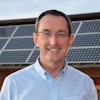Heat Pumps
Design & Installation
Air-to-Water
Hydronics
Small-Scale Chilled Water Cooling

About this course
In other courses we talk a lot about hydronic heating. This course is about using chilled water to provide cooling - you'll learn how these systems work, situations to avoid, and get into the details of some example systems.
This is course is part of our "Heat Pump System Design & Installation" series. You can take an individual course or enroll in the full program, which was created to provide a complete understanding of the design and installation of heat pumps systems.
Learning Objectives
- Benefits of small-scale chilled-water cooling
- Thermal performance of AWHPs and WWHPs in cooling mode
- Terminal units for chilled-water cooling
- Insulating chilled-water piping
- Psychometrics of chilled-water cooling
- Example systems
- Water loop heat pump systems
This course is included in these bundles
Course outline
10 modules
3 hours to complete
2:29 hours
of video lectures
Welcome • 2 assignments
Orientation Materials
Welcome • 2 assignments
Orientation Materials
This course is self-paced, so you don’t need to be logged in at any specific time. You can get started immediately after you enroll and the course materials will remain in your account with minimum guaranteed access for 12 months (1 year) after enrollment.
- Set up email notifications and your student profile
- Introduce yourself on the discussion board
Module 1 • 1 assignments
Advantages of chilled water cooling systems
Module 1 • 1 assignments
Advantages of chilled water cooling systems
- Benefits of small-scale chilled-water cooling (16:41 minutes)
Module 2 • 1 assignments
Thermal performance of AWHPs and WWHPs in cooling mode
Module 2 • 1 assignments
Thermal performance of AWHPs and WWHPs in cooling mode
A review focussing on the cooling performance of air0to-water and water-to-water heat pumps. Proper understanding of this performance is crucial to optimizing subsequent system design and avoiding installation errors.
- Thermal performance of AWHPs and WWHPs in cooling mode (12:11 minutes)
Module 3 • 1 assignments
Terminal units for chilled-water cooling
Module 3 • 1 assignments
Terminal units for chilled-water cooling
This module surveys the hardware available for delivering cooling and dehumidification to interior spaces based on chilled water. It describes sizing and selection.
- Terminal units for chilled-water cooling (14:38 minutes)
Module 4 • 1 assignments
Insulating chilled-water piping
Module 4 • 1 assignments
Insulating chilled-water piping
This module shows why insulation of chilled water piping is critical, and described different materials and methods.
- Insulating chilled-water piping (11:15 minutes)
Module 5 • 1 assignments
Psychometrics of chilled-water cooling
Module 5 • 1 assignments
Psychometrics of chilled-water cooling
This module covers the basic psychrometric concepts needed to understand and design chilled water cooling systems.
- Psychometrics of chilled-water cooling (13:34 minutes)
Module 6 • 1 assignments
Example systems
Module 6 • 1 assignments
Example systems
This modules assembles concepts and details from the previous modules into complete systems that provide chilled water cooling, as well as space heating and in some cases domestic water heating.
- Example systems (34:22 minutes)
Module 7 • 1 assignments
Water loop heat pump systems
Module 7 • 1 assignments
Water loop heat pump systems
This module covers the fundamentals of water loop heat pumps systems used in commercial buildings.
- Water loop heat pump systems (17:21 minutes)
Module 8 • 1 assignments
Systems that separate sensible & latent cooling
Module 8 • 1 assignments
Systems that separate sensible & latent cooling
This modules describes contemporary systems for cooling where the sensible portion fo the cooling load is handled by chilled water circulating through terminal units at temperatures above dewpoint temperature.
- Systems that separate sensible & latent cooling (29:33 minutes)
Conclusion • 4 assignments
Feedback and Additional Resources
Conclusion • 4 assignments
Feedback and Additional Resources
This is our last module but you still have access to the all of course materials for 12 months (1 year), so keep working and you'll be able to complete the course at your own pace. After your year of access expires you can optionally extend access with a HeatSpring Membership. Enjoy the course and keep in touch!
- Knowledge Check - Small-Scale Chilled Water Cooling
- 1 Year of Access to Course Materials
- Feedback: 2-minute Exit Survey
- Certificate of Completion: Request a Certificate
Continuing Education Units
Approved BPI CEU Hours
| BPI Credential | Advanced Hours for Exam |
|---|---|
| 1 | |
| 1 | |
| 1 | |
| 1 | |
| 1 | |
| 1 | |
| 1 | |
| 1 |
Instructor

John Siegenthaler
P.E., Appropriate Designs
John Siegenthaler, P.E., is a mechanical engineering graduate of Rensselaer Polytechnic Institute, a licensed professional engineer, and Professor Emeritus of Engineering Technology at Mohawk Valley Community College. “Siggy” has over 40 years of experience in designing modern hydronic systems. He is a hall-of-fame member of the Radiant Panel Association, and a...
Frequently asked questions
Full FAQHow does this course work?
You can begin this online course instantly upon enrollment. This 8 module course is delivered entirely online. This course is self-paced and you can set your own schedule to complete the materials. You can begin the lecture videos and other course materials as soon as you enroll. During your year of access the instructor will be in the course answering questions on the discussion board. After successfully completing the course, you will be able to generate a certificate of completion.
How long do I have access to the materials?
Students get unlimited access to the course materials as soon as they enroll and for one year (365 days) after enrollment. Rewatch videos and review assignments as many times as you want. View updates the instructor makes to the course as the industry advances. Return to your course anytime with online access from anywhere in the world. After the one year of access expires, access can be extended by joining as a HeatSpring member. A single membership extends access to course materials for all past enrollments.
Is there a certificate of completion?
Yes, when you complete this course you are eligible for a certificate of completion from HeatSpring. You can download your certificate as soon as you have completed all of the course requirements. Students can easily share their verified certificates on their LinkedIn profiles using our LinkedIn integration.
Can I register multiple people?
Yes, please visit our For Teams page to get a group discount.

